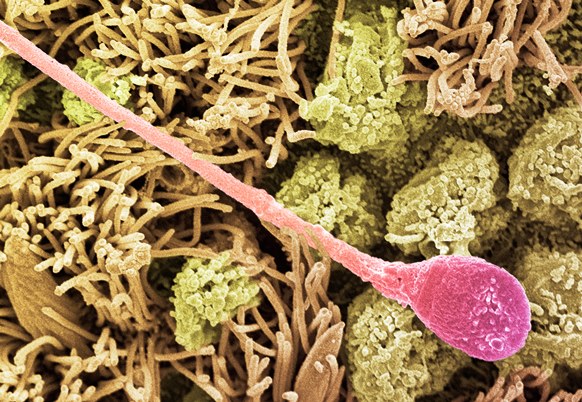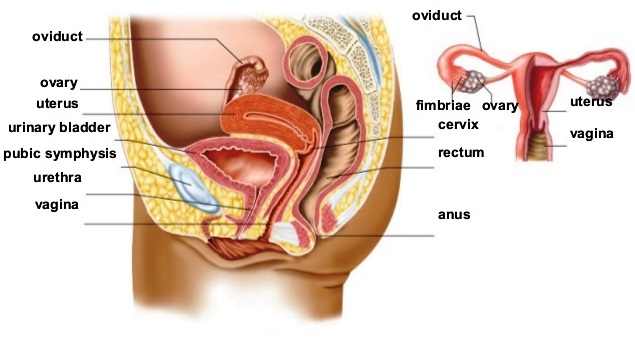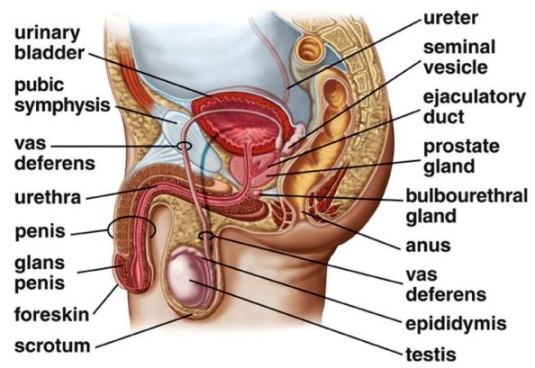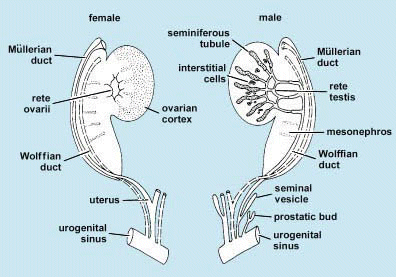Key Concepts
The anatomical structures concerned with the production of sex cells (gametes) and perpetuation of the species. The reproductive system consists of various body organs and glands that ensure the production of new individuals (that is, reproduction). In vertebrates, the reproductive function constitutes the only physiological function that necessitates the existence of two morphologically different kinds of individuals in each animal species—the males and the females (sexual dimorphism). The purpose of the reproductive function is fertilization, that is, the fusion of a male sex cell and a female sex cell produced by two distinct individuals. In each sex, the reproductive system comprises a sex gland or gonad, which produces sex cells (Fig. 1), or gametes, and ducts, which permit the passage of the gametes. In some animals, such as mammals, copulatory organs permit the male germ cells to be introduced into the female ducts, and fertilization is internal; however, in many vertebrates, such as anuran amphibians and many fishes, no copulatory organ exists, and fertilization is external. See also: Animal reproduction; Copulatory organ; Fertilization (animal); Gametogenesis; Gland; Reproductive behavior; Reproductive system disorders; Sexual dimorphism

Anatomy
For both sexes, many of the organs of the reproductive system develop from similar embryonic tissue. However, at later stages of development, specific changes occur that differentiate the female reproductive system (Fig. 2) and the male reproductive system (Fig. 3). See also: Embryology


Egg cells, or ova, and sperm cells, or spermatozoa, are formed in the primary reproductive organs, which are collectively known as gonads—those of the male are called testes, whereas those of the female are called ovaries (Fig. 4). Besides giving rise to reproductive cells, both ovaries and testes give off endocrine secretions, or sex hormones, which pass into the blood or lymphatic streams and are carried to all parts of the body, where they bring about profound effects. The gonads are paired structures; however, in some forms, what appears to be an unpaired gonad is the result of fusion of paired structures or of unilateral degeneration. See also: Endocrinology; Hormone; Oogenesis; Ovary; Ovum; Sperm cell; Spermatogenesis; Testis

The reproductive elements formed in the gonads must be able to be transported. In most vertebrates, ducts are utilized for this purpose. These ducts, together with the structures that serve to bring the gametes of both sexes together, are known as sex organs. The structures used to transport the reproductive cells in the male are known as deferent ducts [ductus (vas) deferens] and those of the female are known as oviducts. In a few forms, no ducts are present in either sex, and eggs and sperm escape from the body cavity through genital or abdominal pores.
Oviducts, except in teleosts and a few other fishes, are modifications of Müllerian ducts formed early during embryonic development. In all female mammals, each differentiates into an anterior, nondistensible Fallopian tube and a posterior, expanded uterus. In all female mammals, except monotremes, the uterus leads to a terminal vagina, which serves for the reception of the penis of the male during copulation. The lower part, or neck, of the uterus is usually telescoped into the vagina to a slight degree. This portion is referred to as the cervix. See also: Fallopian tube; Penis; Uterus
In most vertebrates, the reproductive ducts in both sexes open posteriorly into the cloaca. In some, though, modifications of the cloacal region occur and the ducts open separately to the outside or, in the male, join the excretory ducts to emerge by a common orifice.
The sex of an individual is dependent on the chromosomes received from both parents at the time that the egg is fertilized. However, the balance between maleness and femaleness is a delicate one because environmental factors may assume an influential role in sexual development, and hormonal secretions may modify the extent to which various structures and even behavioral characteristics develop and are maintained. See also: Chromosome; Sex determination
Physiology
The physiological process by which a living being gives rise to another of its kind is considered one of the outstanding characteristics of plants and animals. It is one of the two great drives of all animals: self-preservation and species perpetuation. In contrast to other physiological processes, reproduction in vertebrates can be achieved only by participation of two individuals—the male and the female (Fig. 5). Each produces germ cells called gametes. The male produces spermatozoa and the female produces ova, which carry the biochemical information arranged as genes in the chromosomes for the transmission of inherited characters. No matter how discrepant the pairing gametes may be in size and in form within a species, they contribute the same number of chromosomes. Although reproductive devices are quite different from one species to another, all serve one end, that is, the bringing together of the spermatozoon and the ovum, with each containing half the number of chromosomes of the parent cells. After the union of the chromosomes at fertilization, the newly constituted embryo possesses the proper number of chromosomes of its kind and then divides, differentiates, grows, and develops into an individual either outside the mother (oviparity) or inside the mother (viviparity). The obvious advantage in bisexual reproduction lies in the fact that young produced from the mingled genes of two ancestral lines will not be a direct copy of either parent, but will represent different combinations of ancestral traits with great potential for the survival of the fittest. Reproduction is facilitated or inhibited by environmental and nutritional factors, as well as by all other physiological activities, but it is controlled predominantly by the endocrine system and mediated at least in part by the nervous system. See also: Endocrine system (vertebrate); Nervous system (vertebrate)

Breeding season
The season when animals perform their overt reproductive functions is known as the breeding season. This sexual periodicity is a general phenomenon common to plants and animals. In general, sexual periodicity is predominant in lower vertebrates, but all birds and wild mammals are seasonal breeders. As nutritional and environmental conditions improve, the reproductive season is not so restricted; for example, cattle, the domestic rabbit, and humans all illustrate this fact, although their fertility is higher in spring than in winter. Males of many mammalian species are capable of sperm production and copulation at any time and rarely experience a true sexual period, such as rut in the deer. In mice and rats, the testes do not descend to the scrotum until puberty; in certain other rodents, they descend only during the breeding season. Most vertebrates breed only in spring or summer at the time when food, temperature, and light are optimal; they are then in the best physiological condition for reproduction. Others, for example, sheep, breed at a time that allows parturition to occur at the season of year most suitable for successful survival of the young.
Estrous and menstrual cycles
The cyclic changes of reproductive activities in mammalian females are known as estrous or menstrual cycles (see table). Most mammalian females accept males only at estrus (heat). Estrus in mammals can occur several times in one breeding season; the mare, ewe, and rat come to estrus every 21, 16, and 5 days, respectively, if breeding does not take place. This condition is called polyestrus. The bitch is monestrous; she has only one heat, or estrus, to the breeding season and, if not served then, she does not come into heat again for a prolonged interval (4–6 months according to different breeds). In monestrous and seasonally polyestrous species, the period of sexual quiescence between seasons is called anestrus. See also: Estrus
| Animal | Length |
|---|---|
| Chimpanzee | 37 days |
| Cow | 21 days |
| Guinea pig | 16 days |
| Horse | 21 days |
| Human | 28 days |
| Macaque monkey | 24–26 days |
| Mouse | 5 days |
| Opossum | 28 days |
| Pig | 20–22 days |
| Rat | 5 days |
| Sheep | 16 or 17 days |
The reproductive cycle of the female in the primate and human is well marked by menstruation, that is, the period of blood flow from the vagina. Menstruation does not correspond to estrus, but occurs between the periods of ovulation at the time that the corpus luteum declines precipitously. As a result of the collapse of the superficial capillaries in the endometrium, blood is extravasated in quantity and about two-thirds of the endometrium is desquamated, or shed. After menstruation, there is a period in which the uterus is replenished under the influence of estrogens by the growth of the epithelium and its capillaries. This is known as the proliferative stage and is equivalent to proestrus and estrus in other mammals. See also: Menstruation
Mating
Mating, also called copulation or coitus, is the synchronized bodily activity of the two sexes that enables them to deposit their gametes in close contact. It is essential for successful fertilization because the sperm and ovum have a very limited life span.
The logistics of sperm transport to the site of fertilization in the oviduct present many interesting features in mammals, but it is important to distinguish between passive transport of sperm cells in the female genital tract and sperm migration, which clearly attributes significance to the intrinsic motility of the cell. Viable spermatozoa are actively motile; moreover, although myometrial (uterine) contractions play a major role in sperm transport through the uterus, progressive motility does contribute to migration into and within the oviducts. Even though a specific attractant substance for spermatozoa has not yet been demonstrated to be released from mammalian eggs or their investments, some form of chemotaxis may contribute to the final phase of sperm transport and orientation toward the egg surface.
Fertilization is a process that begins with penetration of the ovum surface layer (zona pellucida) and binding to the vitelline membrane by the fully matured spermatozoon, followed by incorporation of the spermatozoon into the ovum cytoplasm and activation of the ovum. Fertilization takes place in the oviducts of mammals, and the fertilized eggs or embryos do not descend to the uterus for some 3 to 4 days in most species. During this interval, the embryo undergoes a series of mitotic divisions until it comprises a sphere of 8 or 16 cells and is termed a morula. Formation of a blastocyst occurs when the cells of the morula rearrange themselves around a central, fluid-filled cavity, called the blastocoele. As the blastocyst develops within the uterine environment, it sheds its protective coat, the zona pellucida, and undergoes further differentiation before developing an intimate association with the endometrium, which represents the commencement of implantation or nidation. Early development of embryos in most species is largely under the control of the maternal genome, with sequential activation and utilization of oocyte components. See also: Cleavage (developmental biology); Mitosis
Association of the embryo with the uterine epithelium, by either superficial attachment or specific embedding in or beneath the endometrium, leads in due course to the formation of a placenta and complete dependence of the differentiating embryo upon metabolic support from the mother. Implantation and placentation exhibit a variety of forms; however, in all instances, the hormonal status of the mother is of great importance in determining whether or not implantation can proceed. See also: Placentation; Pregnancy
Endocrine function in reproduction
The endocrine glands secrete certain substances (hormones) that are necessary for growth, metabolism, reproduction, response to stress, and various other physiological processes. The endocrine glands most concerned with the process of reproduction are the pituitary and the gonads. Other contributions to the proper functioning of the reproductive system are provided by the thyroid, pineal, and adrenal glands. The hypothalamus is also an important organ for regulating reproduction. See also: Pituitary gland
The formation of gametes (spermatogenesis and oogenesis) is controlled by anterior pituitary hormones. The differentiation of male and female reproductive tracts is influenced, and mating behavior and estrous cycles are controlled, by male or female hormones. The occurrence of the breeding season is mainly dependent on the activity of the anterior lobe of the pituitary, which is influenced through the nervous system by external factors, such as light and temperature. The ratio of light to dark during the daily cycle affects the secretion of melatonin by the pineal gland in the brain. Melatonin can be either stimulatory or inhibitory for reproductive activity in a wide variety of mammals, especially those with defined periods of estrus and anestrus (for example, sheep and many rodents). Its role in human reproduction is uncertain, but it can inhibit ovulation in certain circumstances. The transportation of ova from the ovary to the Fallopian tube and their subsequent transportation, development, and implantation in the uterus are controlled by a balanced ratio between estrogen and progesterone. Furthermore, it is known that estrogens, androgens, and progesterone can have the effect of inhibiting the production or the secretion (or both) of gonadotropic hormones, permitting the cyclic changes of reproductive activity among different animals. See also: Androgens; Estrogen; Melatonin; Pineal gland; Progesterone
Mammary glands are essential for the nursing of young. Their growth, differentiation, and secretion of milk, and in fact the whole process of lactation, are controlled by pituitary hormones as well as by estrogen and progesterone. Other glands and physiological activities also influence lactation, although this is largely via the trophic support of other pituitary hormones. See also: Lactation; Mammary gland





